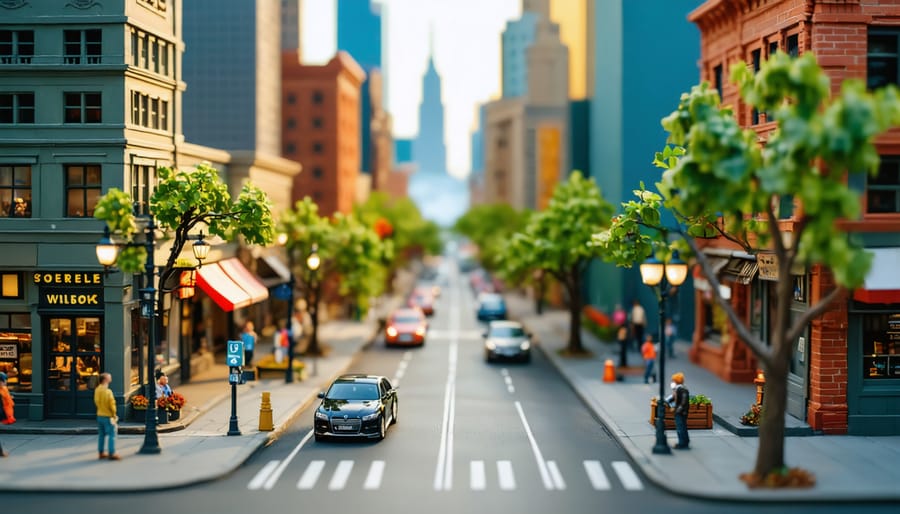
Tilt-shift photography transforms ordinary scenes into miniature wonderlands, bending perspective and focus in ways that challenge our visual expectations. By mechanically adjusting the angle and position of the lens relative to the camera sensor, photographers gain unprecedented control over the focal plane, creating images with selective focus and perspective control that’s impossible with standard lenses. Originally developed for architectural photography to correct converging lines in tall buildings, tilt-shift lenses have evolved into powerful creative tools that let photographers manipulate depth of field and perspective in ways that can make real-world scenes appear like perfectly crafted dioramas.
Beyond the popular miniature effect, these specialized lenses offer practical applications in commercial, architectural, and landscape photography. The tilt movement allows photographers to align the focal plane with subjects at various angles, keeping entire scenes sharp even at wide apertures. Meanwhile, the shift movement enables photographers to capture tall buildings without perspective distortion or create seamless panoramic images without parallax errors.
Whether you’re a professional architect photographer seeking technical precision or an artistic visionary looking to create surreal miniature worlds, understanding tilt-shift photography opens up new creative possibilities that transcend the limitations of conventional lenses. This specialized technique combines technical mastery with creative vision, producing images that continue to captivate viewers and push the boundaries of photographic expression.
Understanding Tilt-Shift Lens Mechanics
The Tilt Function
The tilt function of a tilt-shift lens allows photographers to manipulate the plane of focus in ways that aren’t possible with standard lenses. When you tilt the lens, you change the angle of the focal plane relative to your camera’s sensor, following what’s known as the Scheimpflug principle.
Think of the focal plane as a sheet of glass. With a regular lens, this sheet stays parallel to your camera’s sensor. But when you tilt the lens, that sheet can angle forward or backward, creating a wedge-shaped zone of focus. This manipulation gives you remarkable control over what appears sharp in your image.
For landscape photographers, tilting the lens forward allows you to keep both nearby foreground elements and distant backgrounds in sharp focus, even when using wider apertures. This technique is particularly useful when photographing scenes with leading lines, like rows of flowers stretching into the distance.
In product photography, tilting the lens can help maintain focus across angled subjects, such as when shooting a row of wine bottles or jewelry displayed at an angle. The tilt function also enables creative effects, like selective focus, where you can create a thin slice of sharpness through your composition while letting the rest fall into artistic blur.
Understanding the tilt function takes practice, but mastering it opens up new creative possibilities that simply aren’t achievable with conventional lenses.
The Shift Function
The shift function of a tilt-shift lens is particularly valuable in architectural photography, where it allows photographers to capture tall buildings without the converging vertical lines that typically occur when tilting a camera upward. By shifting the lens up or down while keeping the camera sensor parallel to the building, you maintain those crucial parallel lines that architects and real estate photographers prize.
Think of the shift movement as sliding a window up and down or side to side while keeping it perfectly parallel to your subject. This movement enables you to adjust your composition without changing the camera’s angle, effectively eliminating perspective distortion. When shooting architecture, you can shift the lens upward to capture the top of a building while keeping your camera level with the ground.
The shift function isn’t limited to vertical movements – horizontal shifts are equally useful. In tight urban environments, you can use lateral shifts to photograph buildings from challenging angles or to avoid unwanted elements like poles or trees without moving your camera position. This technique is also invaluable for panoramic photography, allowing you to create seamless wide-format images by shifting the lens rather than rotating the camera.
Interior photographers particularly benefit from shift movements when working in confined spaces. By shifting the lens, you can capture more of a room while maintaining straight lines and proper perspective, creating images that feel natural and true to life.
Essential Tilt-Shift Equipment

Popular Tilt-Shift Lens Models
Several major manufacturers offer outstanding tilt-shift lenses, each with unique characteristics that suit different photography needs. Canon’s TS-E series remains a popular choice, with the TS-E 24mm f/3.5L II being particularly versatile for architecture and landscape photography. This lens offers independent tilt and shift movements and delivers exceptional edge-to-edge sharpness.
Nikon’s PC-E lineup includes the PC-E 24mm f/3.5D ED, which provides similar capabilities to Canon’s offering but with Nikon’s renowned color rendition. The PC-E 85mm f/2.8D is especially favored for portrait and product photography, offering a longer focal length that’s ideal for selective focus effects.
For medium format shooters, the Schneider Kreuznach 90mm LS f/4.5 Tilt-Shift stands out as a premium option. While considerably more expensive, it delivers unmatched image quality and precise movements that professional architectural photographers particularly appreciate.
Budget-conscious photographers might consider the Samyang/Rokinon 24mm f/3.5 Tilt-Shift lens. While it’s manual focus only and lacks some refinements of premium options, it provides similar creative possibilities at a fraction of the cost.
Venus Optics has also entered the market with their Laowa 15mm f/4.5 Zero-D Shift, which, while not offering tilt capabilities, provides an ultra-wide perspective with shift movements perfect for architectural work. Its compact size and reasonable price point make it an attractive option for photographers just beginning to explore shift photography.
Each of these lenses represents different trade-offs between price, build quality, and features, allowing photographers to choose based on their specific needs and budget constraints.
Alternative Solutions
While dedicated tilt-shift lenses offer the best quality, several alternatives can help you achieve similar effects without the hefty investment. Lens adapters, such as the Lensbaby series, provide a more affordable entry point into the world of creative focusing. These adapters allow you to experiment with selective focus techniques while learning the basics of tilt-shift photography.
For the DIY enthusiasts, you can create a simple tilt-shift effect using a standard lens and a flexible bellows or even a modified lens mount. While these homemade solutions require careful handling and won’t match the precision of professional equipment, they’re excellent learning tools and can produce surprisingly good results.
Post-processing software offers another viable alternative. Programs like Adobe Photoshop and Snapseed include tilt-shift simulation tools that can replicate the miniature effect quite convincingly. While digital manipulation can’t fully replicate the unique optical characteristics of genuine tilt-shift lenses, it’s a practical solution for occasional use or when traveling light.
Remember that each alternative comes with its own trade-offs in terms of image quality, control, and ease of use. Choose the option that best fits your creative needs and budget.
Mastering Tilt-Shift Techniques
Miniature Effect Photography
One of the most captivating applications of tilt-shift photography is creating the miniature effect, where real-world scenes appear like carefully crafted dioramas or toy models. This optical illusion occurs by manipulating the plane of focus to create a shallow depth of field that mimics the way our eyes perceive small objects up close.
To achieve the miniature effect, photographers typically position themselves at an elevated vantage point, looking down at their subject at approximately a 30-45 degree angle. The tilt function is then used to create a narrow band of focus, while everything above and below this plane becomes progressively blurrier. This selective focus tricks our brain into perceiving the scene as miniature, as it mirrors how we naturally view small objects.
The effect works particularly well with cityscapes, transportation hubs, and industrial areas. Busy streets with moving vehicles, train yards, or construction sites can be transformed into what appears to be a tiny model world. The key is to choose scenes with strong patterns, repeated elements, and clear compositional lines.
For the most convincing miniature effect, shoot during bright daylight and boost the color saturation slightly in post-processing. This enhances the toy-like appearance by mimicking the vivid colors typically found in model sets. Remember that not every scene will work well – avoid subjects that are too complex or lack clear focal points.
Architectural Photography
In architectural photography, a tilt-shift lens becomes an indispensable tool for capturing buildings with perfect vertical lines and minimal distortion. When shooting tall structures with a standard lens, photographers often need to tilt their cameras upward, resulting in converging lines that make buildings appear to be falling backward. This is where mastering architectural photography techniques with tilt-shift lenses becomes crucial.
The shift function allows photographers to maintain the camera’s sensor parallel to the building while adjusting the lens’s image circle up or down. This correction maintains perfect perpendicular lines without introducing perspective distortion. Professional architectural photographers often combine multiple shifted frames to capture tall buildings in their entirety, creating seamless vertical panoramas with exceptional detail and proper perspective.
Beyond perspective correction, tilt-shift lenses excel in maximizing image quality for architectural work. Their larger image circle and superior edge-to-edge sharpness ensure that fine architectural details remain crisp throughout the frame. This is particularly valuable when photographing intricate façades, historical buildings, or modern architectural designs where detail preservation is paramount.
For interior architecture photography, the shift function proves equally valuable, helping photographers maintain straight lines while working in tight spaces. The ability to shift the lens also allows for creative composition adjustments without moving the camera position, which is often crucial when working with fixed shooting locations or when trying to avoid unwanted reflections.
Creative Applications
While tilt-shift lenses are traditionally used for architectural and product photography, creative photographers have discovered exciting ways to push their artistic boundaries. One popular technique is the “miniature effect,” where selective focus makes real-world scenes appear like tiny models. Try photographing busy city squares, train stations, or industrial areas from elevated positions to create this captivating illusion.
For portrait photography, tilt-shift lenses offer unique creative possibilities. By tilting the lens plane, you can create dreamy, ethereal effects where only a sliver of the subject remains in focus while the rest gracefully dissolves into bokeh. This technique works particularly well for wedding photography and fashion shoots.
Landscape photographers can break traditional landscape composition principles by using tilt-shift creatively. Try tilting the lens opposite to what you’d normally do, creating intentionally “wrong” planes of focus that draw attention to unexpected elements in your scene.
Abstract photographers can experiment with tilt-shift to create surreal perspectives. By combining shift movements with intentional camera rotation, you can produce images with multiple planes of focus that challenge viewers’ perceptions. Urban environments, with their geometric patterns and repetitive elements, provide excellent opportunities for this type of experimentation.
Consider using tilt-shift for macro photography with a twist. The selective focus can make ordinary objects appear extraordinary, transforming simple household items into mysterious landscapes worthy of exploration.
Common Challenges and Solutions
Focus Precision
Mastering focus with tilt movements requires understanding the Scheimpflug principle, which governs how the plane of focus shifts when you tilt your lens. Unlike traditional focusing, where the focal plane remains parallel to your sensor, tilt movements allow you to adjust this plane’s angle, creating unique creative possibilities and solving complex focusing challenges.
To achieve optimal focus, start by positioning your camera parallel to your subject and apply precise focusing techniques before making any tilt adjustments. A methodical approach works best: begin with small tilt movements (1-2 degrees) and observe the changes through your viewfinder or live view display. The focus plane will shift dramatically even with minimal adjustments, so patience is crucial.
When photographing landscapes, try the “swing and tilt” technique: first, focus on your nearest point of interest, then gradually tilt the lens until distant elements come into focus. For architectural shots, use vertical tilt to maintain sharpness from ground to roof. Live view’s magnification feature becomes invaluable here, allowing you to check critical focus across multiple points in your frame.
Remember that increasing tilt angles affects your depth of field characteristics. While this can be advantageous for creative effects, it might require adjusting your aperture to maintain the desired balance between sharp and soft areas in your image.

Exposure Considerations
Working with tilt-shift lenses requires special attention to exposure metering, as the lens movements can significantly affect how light reaches your camera’s sensor. Unlike standard lenses, where exposure control is relatively straightforward, tilt-shift photography introduces unique challenges that need careful consideration.
When tilting or shifting the lens, the camera’s built-in meter may become less reliable because it doesn’t account for the altered light path. This is particularly noticeable when using significant movements or when working with architectural subjects where precise exposure is crucial. To overcome this, many photographers opt for spot metering or manual exposure settings, taking readings from multiple areas of the scene.
A practical approach is to take a test shot with the lens in its neutral position, then make adjustments as you apply tilt or shift movements. Pay special attention to the corners of your frame, as vignetting can become more pronounced with extreme shifts. Using the histogram is essential – it provides a more accurate representation of your exposure than the camera’s LCD screen alone.
Remember that different aperture settings can affect the intensity of the tilt-shift effect. While you might be tempted to shoot wide open for maximum blur, stopping down to f/8 or f/11 often provides the best balance between creative effect and overall image quality. When in doubt, bracketing your exposures can help ensure you capture the perfect shot.

Tilt-shift photography opens up a world of creative possibilities that can transform your architectural, landscape, and miniature effect photography. By mastering the unique movements of these specialized lenses, you can achieve perfect perspective control, selective focus, and that distinctive miniature look that has captivated viewers for decades.
Remember that while tilt-shift lenses require practice and patience, the results are well worth the investment of time and effort. Start with simple applications like correcting converging lines in architectural shots, then gradually experiment with creative techniques like the miniature effect or selective focus in landscapes.
Don’t feel pressured to immediately purchase expensive tilt-shift lenses. Consider renting equipment first to explore different focal lengths and determine which best suits your photography style. Many of the principles we’ve discussed can also be practiced using post-processing techniques, helping you understand the effects before committing to specialized gear.
Whether you’re a professional architect photographer seeking technical perfection or an creative enthusiast looking to add unique perspectives to your portfolio, tilt-shift photography offers endless opportunities for growth and artistic expression. Take time to experiment, learn from your mistakes, and most importantly, enjoy the journey of discovering this fascinating aspect of photography. The skills you develop will not only enhance your technical capabilities but also expand your creative vision in ways you might never have expected.





















